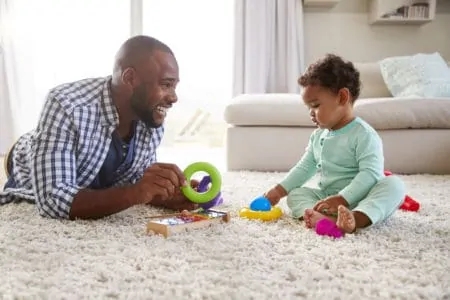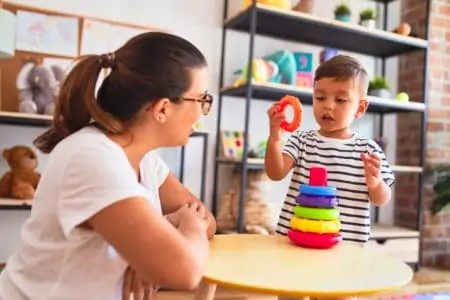After a child has spent months lying down or reclining in their seats, it’s common for parents to wonder, “When do babies sit up?” Since every child is different, an exact answer is tricky to give.
Sitting up independently is a significant milestone. Once babies achieve this, they can explore the world from a new angle, using their hands and arms to reach.
We’ll share what we’ve learned on this topic from our research and personal experience. We’ll help you recognize the signs that your baby is ready to sit and learn to help them with this milestone. We’ll also explain when you should be concerned if your baby isn’t sitting yet and what to do.
Key Takeaways
- Babies typically sit independently between 6 and 7 months, but each child is different.
- Signs your baby is ready include being able to roll and support their head while upright.
- To help your baby sit up, engage in tummy time, prop them up, help them up, and use toys designed for sitting.
- Consult your pediatrician if your baby cannot hold their head steadily by 4 months or sit unsupported by 9 months.
When Do Babies Sit Up?
The age at which a baby sits up differs from child to child. Some master the art of sitting quickly, while others require more time. Around 3 to 5 months, your baby might be capable of sitting while being supported by you or a seat. However, they will fall if you let go.
You may notice your 4-month-old showing interest in sitting by attempting to lift their head and shoulders while lying on their back. It can look as if they are doing “crunches.” This is a sign that your baby wants to look at the surroundings more, something that is difficult to do when lying flat.
By 5 months old, most infants learn how to place their hands in front with arms outstretched to hold themselves up in a “tripod” position. Babies will typically sit up by themselves between 6 and 7 months (1). They must first be able to support their head to avoid toppling over.
Initially, your little one will probably sit unsupported for a couple of seconds to a minute before falling.
As the muscles get stronger and balance is established, They can sit for longer periods. This usually occurs around 7 to 8 months. At this stage, your baby may topple over sometimes simply because they’re bored of sitting.
If your infant was born prematurely, they may achieve this milestone a month or two later than a full-term infant. Your doctor can explain what milestones to expect for the corrected age. (2)
Signs Your Baby Is Ready
A sign of readiness to sit is when a baby can roll and support their head while upright. Most babies, by 4 or 5 months, can still not fully support the head when you pull them to a sitting position.
To check for readiness, grab both hands while they’re lying on their back and pull up slowly. While you pull them up, observe whether their head falls backward. If it does, you should wait — their heads must follow the upper body when you pull their arms.
How Babies Learn to Sit Up
You can place your baby in a sitting position practically from day one. However, independent sitting won’t happen until they have proper head control. The muscles in a baby’s neck require time to develop — most will have done this sufficiently by around 6 months.
At approximately the 4-month mark, your baby’s neck and head muscles begin to strengthen rapidly. You may notice during tummy time that your little one can raise their head and hold it. This is also when they’ll start to roll over, which is a required milestone to achieve before sitting. Most babies can roll from belly to back by 4 months but may not roll from back to belly until 6 months of age.
As your baby spends time on their stomach, they will soon figure out how to use their arms to push off the ground. They may begin doing baby push-ups. All these mini-exercises help build the muscles required to sit.
By around 5 months, some babies can sit momentarily by themselves. You should always be close to support them and to cushion a fall.
When their muscles are strong enough, babies will begin to figure out how to keep their balance while sitting. Your baby’s posture may resemble a tripod initially. They’ll be tilted forward with one or both arms in front.
At around 7 months, your baby will probably have established adequate muscles and balance to sit unsupported. Now it’s time for exploring — the hands are finally free to grab toys and other nearby objects.
Confidently sitting alone isn’t likely to happen until 8 months. By 9 months, your baby will also be able to switch from tummy to sitting by pushing up with their arms (3).
How to Help Your Baby Sit Up
1. Tummy Time
Tummy time is a crucial exercise to help engage your baby as early as possible. It consists of placing your little one on their stomach for a few minutes at a time.
Doing tummy time will help develop your baby’s neck and shoulder muscles while also promoting the development of motor skills. It builds the foundation your little one needs for rolling over, sitting up, and crawling (4).
Another benefit of this exercise is that it prevents flat spots on the head. Small babies have soft skulls, and when lying on their backs for prolonged periods, the bone moves and becomes flat (5). This can be corrected, but it’s best avoided. (6)
Tummy time helps your baby discover a different view of the world. However, you should always place your baby on the back when sleeping or unsupervised. Otherwise, you could run the risk of sudden infant death syndrome (SIDS) (7).
For successful tummy time, always pick moments when your baby is awake and alert. Avoid doing it straight after nursing — wait at least 30 minutes to give your baby time to digest their food.
Place a blanket on a clear area on your floor, then gently roll your baby over so they’re on their stomach. Let them stay on their belly for three to five minutes while you interact with them. Aim to do this two to three times a day. As your baby gets older, do it more frequently and for longer periods.
You can use some toys to encourage your baby to look forward and lift their head. Place it just within reach to help them.
In my medical practice, I begin recommending tummy time at the 2-week-old well visit. Many parents do not realize that it is OK to start this young. Doing so improves neck muscle strength significantly. I also remind parents to continue the routine of tummy time at the 2- and 4-month-old visits.Parents often complain to me that their baby “hates tummy time.” As soon as the infant is placed on their belly, they cry. To prevent long periods of crying and stressed-out parents, I recommend doing belly time for only 1 minute but at every diaper change. In this way, the baby gets some belly time but doesn’t have to stay in this position for very long. Also, I find that associating belly time with diaper changes prevents parents from forgetting to do it.
Editor's Note:
Dr. Leah Alexander, MD, FAAP2. Prop Them Up
A good way to help babies work the muscles needed for sitting is to prop them up in a supported sitting position. You can have your baby lean on a breastfeeding support pillow or a Boppy pillow. Your legs also work if you sit on the floor with your baby between them.
However, you shouldn’t rush this. If your baby isn’t showing signs of being ready to sit this way, don’t force it. It can be tiring and will inevitably make your baby cranky.
Also, avoid propping your baby up in their stroller or car seat. Strollers that do not recline are not recommended under the age of 6 months (8). Such seats are constrained, inhibiting your baby from moving, rolling, wiggling, and reaching. Always sit on a mat or carpet on the floor.
3. Help Them Up
Once your little one can lift their head, you can try pulling them up from a lying position. While lying on the back, grab each hand and gently pull them up toward you. Almost all babies love this — it’s fun for them, especially if you make funny faces and noises.
Another benefit of this exercise is that your baby will familiarize themself with the movement required to sit up. As the muscles strengthen, you can begin to let go once they’re in a sitting position. Keep your arms close around them to prevent a fall, and place lots of pillows for cushioning.
4. Try a Toy
Invest in a toy that’s designed to help your baby sit. Items like stationary play centers are excellent for 3- to 4-month-old babies. They provide ample support for your baby’s needs when starting to sit upright.
Many stationary play centers have lights and sounds, pull toys, or wheels babies can turn. These will keep them interested and distracted while exercising their sitting muscles. You can also find multi-stage booster seats, which help infants remain upright for playtime.
Colorful cubes, balls, or stacking toys are a great alternative to keep your baby interested while sitting. Once seated, play an interactive game by stacking toys or bouncing a ball (9).
What Comes Next
Sitting up unsupported is only the first step. Once your baby is ready and confident, they may begin to lean forward to balance on their hands and knees. As they get the hang of it, your little one will probably get onto all fours and rock back and forth.
Then, the early stages of crawling come at around 6 or 7 months. You can expect to see some boot-camp-like creeping across the floor, using the arms to drag their belly. By 10 months, your little one will likely be a professional crawler looking to upgrade their skills to walking. However, not every infant crawls.
Some babies are more interested in trying to stand and may completely skip the crawling stage. Signs of this are attempts to get onto the feet instead of the knees. At 9 months old, your baby may hold onto the side of the crib and pull up to a standing position. If so, the next stage is for them to “cruise,” taking steps while holding onto objects and furniture.
Once they reach this stage, it’s essential for you to babyproof your home. Even babies who are sitting can quickly get into mischief. Ensure there are no dangling cords or small items on the floor which they could swallow (10).
What If My Baby Doesn’t Sit Up?
Timelines for milestones differ from baby to baby. However, if your baby can’t hold the head steadily by around 4 months or sit unsupported by 9 months, consult your pediatrician.
That said, don’t panic yet — every baby develops differently — some are quick, while others take their time. Always ask your baby’s doctor if you’re worried. Developmental delays are best solved when discovered early on.
Preemies






